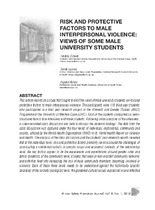Risk and protective factors to male interpersonal violence: views of some male university students

View/
Date
2010Author
Clowes, Lindsay
Lazarus, Sandy
Ratele, Kopano
Metadata
Show full item recordAbstract
This article reports on a study that sought to elicit the views of male university students on risk and
protective factors to male interpersonal violence. The participants were 116 third-year students
who participated in a final year research project in the Women’s and Gender Studies (WGS)
Programme at the University of Western Cape (UWC). Each of the students conducted six semistructured
face to face interviews with male students. Following initial analyses of the interviews,
a video-recorded class discussion was held to discuss the research findings. The data from the
class discussion was captured under the four levels of individual, relationship, community and
society, utilised by the World Health Organization (WHO) in its World Health Report on Violence
and Health. The analysis of the class discussion and the students’ own research reports revealed
that at the individual level, risk and protective factors primarily revolve around the challenges of
constructing a viable masculinity in specific social and economic contexts; at the relationship
level, the key factors appear to be the experiences and expectations around gender roles and
family dynamics; at the community level, it seems that weak or non-existent community networks
and activities feed into increasing the risk of male community members becoming involved in
violence. Each of these three levels needs to be understood against the historically specific
backdrop of the societal ecological level: the gendered cultural values expressed in and reflected
